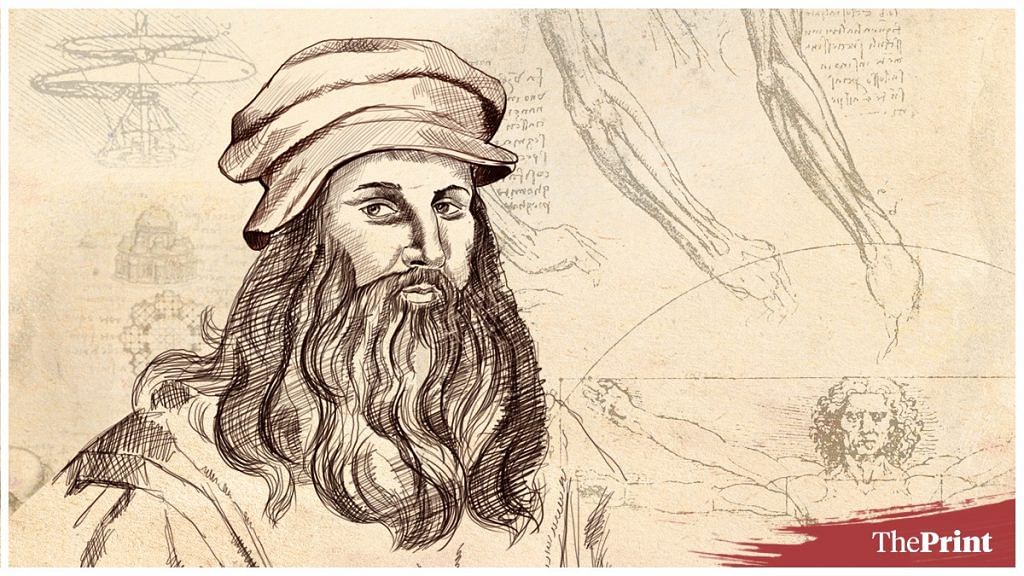New Delhi: Was Leonardo da Vinci’s talent genetic? Which of his artworks have his genetic ‘footprint’? And where is the Italian polymath’s final resting place? An extensive study into the historical records of the da Vinci family claims to have identified 14 living male descendants of the famous painter, a finding that has the potential to answer all of these questions.
The study is part of a decades-old project to identify da Vinci’s descendants in a bid to answer some lingering mysteries about the 15th-century genius, who never had his own children.
Titled the Leonardo da Vinci DNA Project, the initiative is led by art historians Alessandro Vezzosi and Agnese Sabato.
Vezzosi and Sabato had disclosed 35 alleged descendants of da Vinci — male and female — in 2016, which included the Oscar-nominated film-maker Franco Zeffirelli, who died in 2019.
The 2016 announcement only included two males, up to the 19th generation, from a single branch of the Vinci family.
The latest findings seek to fill gaps and correct errors in previous genealogical research into the family, while offering new discoveries and family tree updates.
The study documents a continuous male line — from father to son — which is important for genetic studies.
The Y chromosome, passed on to male descendants, is known to remain almost unchanged through 25 generations. Comparing the Y chromosome of today’s male relatives with that of their ancestors in ancient and modern burial sites could both verify the uninterrupted family line and certify da Vinci’s own Y-chromosome marker.
To this end, the researchers claim to have documented the da Vinci male line from “progenitor” Michele (born before 1331), to Leonardo (born 1452), and forward — presenting a family tree comprising five branches.
While da Vinci had no children, he had at least 22 half-brothers. The five family branches are traced from his father Ser Piero (5th generation), and half-brother Domenico (6th). Since the 15th generation, data has been collected on over 225 individuals.
According to the researchers, all the alleged male living descendants are from Italy, with the oldest aged 85 years and the youngest born in 2020. They are employed across various professions — the octagenarian, for example, is a porcelain retailer and co-founder of an aeroclub, with several inventions to his name, according to the study.
Others include a glass-maker, retired artisans, and a motorcycle enthusiast.
The fresh findings have been released as part of a peer-reviewed study published in the journal Human Evolution.
Also read: How making children think like Leonardo da Vinci can help tackle climate change
The genetic trail of a genius
This 690-year genealogical investigation is fundamental to answering several questions regarding the life and work of Leonardo da Vinci, including his final resting place.
Finding his DNA is believed to be key to identifying some of his original work since da Vinci never signed it. However, reconstructing the Italian painter’s DNA so far has been difficult because the exact location of his buried remains is unknown.
The Renaissance painter was buried in the church of St Florentin in Amboise, France, in 1519, but the church was demolished during the French Revolution in the late 18th century.
In 1863, Arsène Houssaye — a French writer and inspector general of provincial museums in France — received an imperial commission to excavate the site.
He discovered a partial skeleton with a bronze ring on one finger, white hair, and stone fragments bearing the inscriptions that likely formed the words “Leonardus Vinci”.
A silver shield found near the bones depicted a beardless Francis I, the French king da Vinci served in his final years.
The bones were interred in 1874 at the chapel of Saint Hubert, with plaques in French and Italian stating they are the “presumed remains” of the Renaissance master.
Vezzosi later found evidence that Houssaye had kept two relics from these remains for himself — a lock of hair and the ring. Houssaye’s great-grandson sold these relics in 1925 to Harold K. Shigley, an American collector.
In 1985, the two relics were acquired by another American collector, who got in touch with Vezzosi’s team in 2016, after they released their findings on the descendants.
The key to confirming whether the hair is that of da Vinci lies in the DNA of his descendants.
The current study, for the first time, provides documentary data and information sources from over seven centuries to the present-day registry office.
If the DNA from these hair samples match those of the living descendants, the painter’s resting place will finally be confirmed.
‘We will continue to investigate other branches’
Once the DNA is confirmed, it can answer several other questions — including the factors behind his genius, his physical prowess, premature ageing, left-handedness, diet, health and any hereditary diseases, and if da Vinci’s talent was a result of enhanced sensory perception. Such findings are of value to art historians, since they throw light on the artist’s life.
Moreover, modern technology can recreate da Vinci’s face in 3D using his DNA sequence, the researchers said.
“The current study will allow to proceed with the verification by comparing the Y chromosome of living descendants with the ancient ‘Houssaye find’ (lock of hair),” Sabato told ThePrint.
“We will continue to investigate other branches of the da Vinci genealogy and create the database ‘GeniaDaVinci’ to share all the documentary sources to make these discoveries available to scholars and anybody all over the world,” Sabato said.
“We are collaborating for the scientific examinations of burials and living descendants to identify Leonardo’s DNA,” she added. The team said that they hope to safeguard the places where da Vinci lived.
(Edited by Sunanda Ranjan)
Also read: Discovery of hidden microbes on da Vinci drawings could help preserve them better
